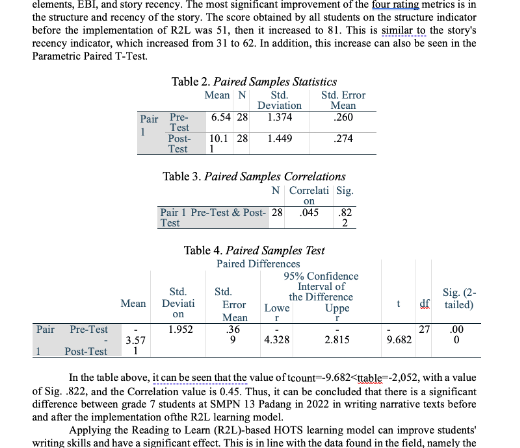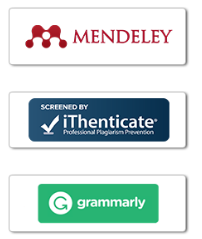The Influence of R2L-Based HOTS Learning on Narrative Text Writing Skills for Junior High School Students
DOI:
https://doi.org/10.26555/bs.v45i1.1013Keywords:
R2L-Based Learning, Higher Order Thinking Skills (HOTS) , Narrative Text , WritingAbstract
This study aimed to describe the effect of implementing the R2L learning model on improving students' writing narrative text skills. The researcher identified the research sample, namely the 7th-grade students of SMPN 13 Padang, totaling 28 students. The researcher collected data by processing the pre-test results from the representations obtained before applying the R2L model and the post-test results obtained after applying the R2L model. The data were analyzed using the Paired T-Test parametric analysis method. The results found are that the Reading to Learn (R2L)-based HOTS learning model can improve students' writing skills and have a significant effect. This is in line with the data found in the field, namely the pretest-posttest results with a value of tcount=-9.682<ttable=-2,052.
References
Acar, A. S. (2023). Genre pedagogy: A writing pedagogy to help L2 writing instructors enact their classroom writing assessment literacy and feedback literacy. Assessing Writing, 56. https://doi.org/10.1016/j.asw.2023.100717
Ahmadi Safa, M., & Motaghi, F. (2024). Cognitive vs. metacognitive scaffolding strategies and EFL learners’ listening comprehension development. Language Teaching Research, 28(3). https://doi.org/10.1177/13621688211021821
Bora, P. (2023). Importance of Writing Skill to Develop Students’ Communication Skill. Journal for Research Scholars and Professionals of English Language Teaching, 7(35). https://doi.org/10.54850/jrspelt.7.35.009
Culican, S. J. (2007). Troubling teacher talk: The challenge of changing classroom discourse patterns. Australian Educational Researcher, 34(2). https://doi.org/10.1007/BF03216855
Damayanti, I. L. (2017). From storytelling to story writing: The implementation of reading to learn (R2L) pedagogy to teach english as a foreign language in Indonesia. Indonesian Journal of Applied Linguistics, 6(2). https://doi.org/10.17509/ijal.v6i2.4870
Defazio, J., Jones, J., Tennant, F., & Hook, S. A. (2010). Academic Literacy: The Importance and Impact of Writing across the Curriculum‐A Case Study. Journal of the Scholarship of Teaching and Learning, 10(2).
Fernandez, L. (2018). Qualitative interview analysis: The use of systemic functional linguistics to reveal functional meanings. Forum Qualitative Sozialforschung, 19(2). https://doi.org/10.17169/fqs-19.2.2663
Han, J., & Hiver, P. (2018). Genre-based L2 writing instruction and writing-specific psychological factors: The dynamics of change. Journal of Second Language Writing, 40. https://doi.org/10.1016/j.jslw.2018.03.001
Hasan, R., & Ahmad, N. A. (2018). Conceptual Framework of Scaffolding Literacy Module to help Remedial Students Mastering Reading Skills. International Journal of Academic Research in Business and Social Sciences, 8(11). https://doi.org/10.6007/ijarbss/v8-i11/4982
Hecht, C. A., Murphy, M. C., Dweck, C. S., Bryan, C. J., Trzesniewski, K. H., Medrano, F. N., Giani, M., Mhatre, P., & Yeager, D. S. (2023). Shifting the mindset culture to address global educational disparities. Npj Science of Learning, 8(1). https://doi.org/10.1038/s41539-023-00181-y
Husein, R., Restu, R., Sembiring, M., Wulandari, S., Andary, S., & Rahman, M. A. (2022). Reading to Learn (R2L) Model to Activate Students on Reconstruction Short Story. Budapest International Research and Critics in Linguistics and Education (BirLE) Journal, 5(1).
Hutabarat, D. S. A., & Gunawan, W. (2021). GBA in Teaching Writing to Scaffold Students in Online Learning. Proceedings of the Thirteenth Conference on Applied Linguistics (CONAPLIN 2020), 546. https://doi.org/10.2991/assehr.k.210427.016
Kadyrov, N., Mujiyanto, J., & Wuli Fitriati, S. (2023). Errors in Discourse Marker Usage in Descriptive Texts by SMA Negeri 12 Semarang Students. English Education Journal, 13(2). https://doi.org/10.15294/eej.v13i2.74097
Kim, Y. S. G., Yang, D., Reyes, M., & Connor, C. (2021). Writing instruction improves students’ writing skills differentially depending on focal instruction and children: A meta-analysis for primary grade students. In Educational Research Review (Vol. 34). https://doi.org/10.1016/j.edurev.2021.100408
Lestari, T., Damayanti, I. L., & Nurlaelawati, I. (2022). Reading to Learn (R2L) Pedagogy: Teaching Reading Comprehension to a Young English Language Learner. JoLLA: Journal of Language, Literature, and Arts, 2(11). https://doi.org/10.17977/um064v2i112022p1558-1569
Lin, T. C., Tang, K. Y., Lin, S. S., Changlai, M. L., & Hsu, Y. S. (2022). A Co-word Analysis of Selected Science Education Literature: Identifying Research Trends of Scaffolding in Two Decades (2000–2019). In Frontiers in Psychology (Vol. 13). https://doi.org/10.3389/fpsyg.2022.844425
Listyani, L. (2018). Enhancing Academic Writing Skills through “Reading to Learn” Strategy. Arab World English Journal, 9(1). https://doi.org/10.24093/awej/vol9no1.19
Liu, Z., Hua, J., & Zhang, Z. (2022). Scaffolding Instruction in Virtual Language Learning. Journal of Language Teaching and Research, 13(2). https://doi.org/10.17507/jltr.1302.20
Martin, J. R., & Rose, D. (2007). Interacting with Text: the role of dialogue in learning to read and write. Foreign Studies Journal.
Marzuki, Widiati, U., Rusdin, D., Darwin, & Indrawati, I. (2023). The impact of AI writing tools on the content and organization of students’ writing: EFL teachers’ perspective. Cogent Education, 10(2). https://doi.org/10.1080/2331186X.2023.2236469
Masava, B., Nyoni, C. N., & Botma, Y. (2023). Scaffolding in Health Sciences Education Programmes: An Integrative Review. In Medical Science Educator (Vol. 33, Issue 1). https://doi.org/10.1007/s40670-022-01691-x
Menco-Haeckermann, V. (2021). From Curriculum Demands to Genre Pedagogy: Bilingual Adaptation of Reading to Learn for an L2 Lesson Planning. Signo, 46(86). https://doi.org/10.17058/signo.v46i86.16522
Olsson, E. M., Gelot, L., Karlsson Schaffer, J., & Litsegård, A. (2024). Teaching Academic Literacies in international relations: towards a pedagogy of practice. Teaching in Higher Education, 29(2). https://doi.org/10.1080/13562517.2021.1992753
Paesani, K. (2016). Investigating connections among reading , writing , and language development : A multiliteracies perspective. Reading in a Foreign Language, 28(2).
Perl, S. (2014). Research as a Recursive Process: Reconsidering “The Composing Processes of Unskilled College Writers” 35 Years Later. Composition Forum, 29(29).
Rahnuma, N. (2023). Exploring ESL students’ experiences of academic writing in higher education- a cultural historical activity theory perspective. Education Inquiry. https://doi.org/10.1080/20004508.2023.2222450
Rusmiyanto, R., Huriati, N., Fitriani, N., Tyas, N. K., Rofi’i, A., & Sari, M. N. (2023). The Role Of Artificial Intelligence (AI) In Developing English Language Learner’s Communication Skills. Journal on Education, 6(1). https://doi.org/10.31004/joe.v6i1.2990
Saragih, J. Y., Adisaputera, A., & Saragi, D. (2019). The Effect of Reasoning Skills on Writing of Explanation Text Assessed from the Social Economic Status of Parents in Class VIII, SMP Negeri 2 Raya, Simalungun District, Indonesia. Budapest International Research and Critics in Linguistics and Education (BirLE) Journal, 2(3). https://doi.org/10.33258/birle.v2i3.354
Senisum, M., Susilo, H., Suwono, H., & Ibrohim. (2022). GIReSiMCo: A Learning Model to Scaffold Students’ Science Process Skills and Biology Cognitive Learning Outcomes. Education Sciences, 12(4). https://doi.org/10.3390/educsci12040228
Shum, M. S. kee, Tai, C. P., & Shi, D. (2018). Using ‘Reading to Learn’ (R2L) pedagogy to teach discussion genre to non-Chinese-speaking students in Hong Kong. International Journal of Bilingual Education and Bilingualism, 21(2). https://doi.org/10.1080/13670050.2016.1159653
Suastra, I. M., & Menggo, S. (2020). Empowering students’ writing through performance assessment. International Journal of Language Education, 4(3). https://doi.org/10.26858/ijole.v4i3.15060
Subandiyah, H., Supratno, H., Permata, R., Rosyid, A., Minarti, E., & Nur Abida, F. I. (2023). Teaching Indonesian Language for Foreign Speakers in the State University of Surabaya: Strategies and Challenges. Randwick International of Education and Linguistics Science Journal, 4(2). https://doi.org/10.47175/rielsj.v4i2.667
Syarifah, E. F., & Gunawan, W. (2016). Scaffolding in the Teaching of Writing Discussion Texts Based on SFL Genre-based Approach. English Review: Journal of English Education, 4(1). https://doi.org/10.25134/erjee.v4i1.306
Tang, K. Y., Wang, C. Y., Chang, H. Y., Chen, S., Lo, H. C., & Tsai, C. C. (2016). The Intellectual Structure of Metacognitive Scaffolding in Science Education: A Co-citation Network Analysis. International Journal of Science and Mathematics Education, 14(2). https://doi.org/10.1007/s10763-015-9696-4
Wang, R. (2021). A Study of Junior High School English Writing Teaching Based on Scaffolding Theory. IRA International Journal of Education and Multidisciplinary Studies, 17(3). https://doi.org/10.21013/jems.v17.n3.p3
Wildsmith-Cromarty, R., & Steinke, K. (2014). The write approach: Can R2L help at tertiary level? Per Linguam, 30(1). https://doi.org/10.5785/30-1-570
Yong, L. (2022). The Effects of Scaffolding in the L2 Classroom: Teacher Support in Relation to Student In-class Engagement and Appreciation of Support. Proceedings of the 2021 International Conference on Education, Language and Art (ICELA 2021), 637. https://doi.org/10.2991/assehr.k.220131.150
Yulianeta, Y. (2022). Implementing Reading to Learn (R2L) Pedagogy to Help Indonesian Junior High School Students Generate News Report Text. PAROLE: Journal of Linguistics and Education, 12(1). https://doi.org/10.14710/parole.v12i1.130-137

Downloads
Published
Issue
Section
License
Copyright (c) 2025 Yenni Hayati, Ayu Gustia Ningsih, Yulianti Rasyid

This work is licensed under a Creative Commons Attribution-ShareAlike 4.0 International License.

1.jpg)






